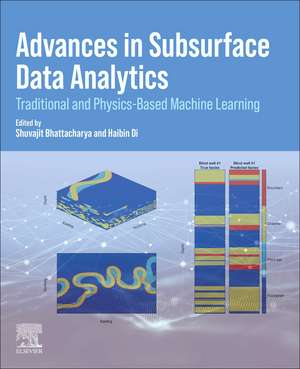Advances in Subsurface Data Analytics
Editat de Shuvajit Bhattacharya, Haibin Dien Limba Engleză Paperback – 20 mai 2022
Advances in Subsurface Data Analytics: Traditional and Physics-Based Approaches will help researchers in academia and professional geoscientists working on the subsurface-related problems (oil and gas, geothermal, carbon sequestration, and seismology) at different scales to understand and appreciate current trends in ML approaches, their applications, advances and limitations, and future potential in geosciences by bringing together several contributions in a single volume.
- Covers fundamentals of simple machine learning and deep learning algorithms, and physics-based approaches written by practitioners in academia and industry
- Presents detailed case studies of individual machine learning algorithms and optimal strategies in subsurface characterization around the world
- Offers an analysis of future trends in machine learning in geosciences
Preț: 673.62 lei
Preț vechi: 879.67 lei
-23% Nou
Puncte Express: 1010
Preț estimativ în valută:
128.89€ • 134.94$ • 106.65£
128.89€ • 134.94$ • 106.65£
Carte tipărită la comandă
Livrare economică 29 martie-12 aprilie
Livrare express 01-07 martie pentru 85.20 lei
Preluare comenzi: 021 569.72.76
Specificații
ISBN-13: 9780128222959
ISBN-10: 0128222956
Pagini: 376
Dimensiuni: 191 x 235 x 24 mm
Greutate: 0.64 kg
Editura: ELSEVIER SCIENCE
ISBN-10: 0128222956
Pagini: 376
Dimensiuni: 191 x 235 x 24 mm
Greutate: 0.64 kg
Editura: ELSEVIER SCIENCE
Cuprins
Part 1: Traditional Machine Learning Approaches
1. User Vs. Machine Seismic Attribute Selection for Unsupervised Machine Learning Techniques: Does Human Insight Provide Better Results Than Statistically Chosen Attributes?
2. Relative Performance of Support Vector Machine, Decision Trees, and Random Forest Classifiers for Predicting Production Success in US unconventional Shale Plays
Part 2: Deep Learning Approaches
3. Recurrent Neural Network: application in facies classification
4. Recurrent Neural Network for Seismic Reservoir Characterization
5. Application of Convolutional Neural Networks for the Classification of Siliciclastic Core Photographs
6. Convolutional Neural Networks for Fault Interpretation – Case Study Examples around the World
Part 3: Physics-based Machine Learning Approaches
7. Scientific Machine Learning for Improved Seismic Simulation and Inversion
8. Prediction of Acoustic Velocities using Machine Learning
9. Regularized Elastic Full Waveform Inversion using Deep Learning
10. A Holistic Approach to Computing First-arrival Traveltimes using Neural Networks
Part 4: New Directions
11. Application of Artificial Intelligence to Computational Fluid Dynamics
1. User Vs. Machine Seismic Attribute Selection for Unsupervised Machine Learning Techniques: Does Human Insight Provide Better Results Than Statistically Chosen Attributes?
2. Relative Performance of Support Vector Machine, Decision Trees, and Random Forest Classifiers for Predicting Production Success in US unconventional Shale Plays
Part 2: Deep Learning Approaches
3. Recurrent Neural Network: application in facies classification
4. Recurrent Neural Network for Seismic Reservoir Characterization
5. Application of Convolutional Neural Networks for the Classification of Siliciclastic Core Photographs
6. Convolutional Neural Networks for Fault Interpretation – Case Study Examples around the World
Part 3: Physics-based Machine Learning Approaches
7. Scientific Machine Learning for Improved Seismic Simulation and Inversion
8. Prediction of Acoustic Velocities using Machine Learning
9. Regularized Elastic Full Waveform Inversion using Deep Learning
10. A Holistic Approach to Computing First-arrival Traveltimes using Neural Networks
Part 4: New Directions
11. Application of Artificial Intelligence to Computational Fluid Dynamics
